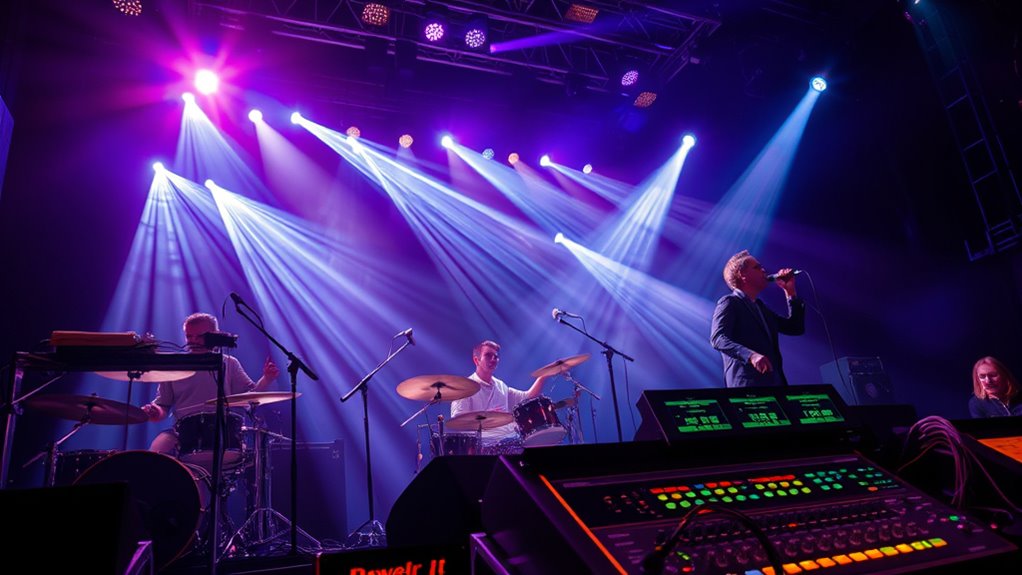To guarantee perfect sound sync during live performances, use high-quality equipment with low latency and connect everything through professional-grade cables. Test and calibrate audio and video sources beforehand, making small, real-time adjustments during the show using delay controls. Assign a technician to constantly monitor the sync and make quick tweaks as needed. Mastering these techniques will help you deliver seamless audio-visual experiences—keep exploring to discover more expert tips for flawless synchronization.
Key Takeaways
- Use high-quality, low-latency cables and interfaces to minimize audio delay.
- Perform thorough pre-performance testing to identify and correct sync issues early.
- Adjust real-time delay settings on mixing consoles or DAWs for precise alignment.
- Assign dedicated personnel to monitor and make quick adjustments during the show.
- Understand equipment latency profiles and select hardware with built-in latency compensation features.

Achieving perfect sound sync is essential for a seamless viewing experience, yet it often feels elusive. When you’re on stage or managing a live performance, even a slight delay between audio and visuals can distract your audience and diminish the overall impact. To master sound synchronization, you need a combination of proper equipment setup, real-time adjustments, and a keen understanding of how sound and visuals interact. Your first step is to guarantee your audio and video sources are connected through high-quality, low-latency equipment. Using professional-grade cables and interfaces minimizes delays caused by signal transmission. It’s also critical to set up your audio system in a way that reduces any potential latency—this might mean positioning your audio processing units close to your sound source or using hardware with built-in latency compensation.
Ensuring high-quality, low-latency connections is key to perfect sound synchronization during live performances.
Once your equipment is in place, you should test your setup thoroughly before the performance begins. This means playing a video with synced audio and observing closely for any lag. Use a stopwatch or a visual cue, like a person clapping their hands, and see if the sound aligns with the visual. If not, you can often adjust the audio delay settings on your mixing console or digital audio workstation. Many modern devices have real-time delay controls, allowing you to fine-tune synchronization during the performance without interrupting the show. Remember, small adjustments can make a significant difference—don’t hesitate to tweak until the audio and visuals are perfectly aligned. Additionally, understanding the latency of your equipment helps you anticipate and compensate for delays more effectively.
Another key aspect is to monitor your sound constantly during the event. Live environments are dynamic—things can shift, and equipment might introduce unexpected delays. Using a technician or a dedicated person to keep an eye on the synchronization helps you catch issues early. They can make quick adjustments on the fly, ensuring your audience experiences seamless audio-visual harmony. Additionally, understanding the inherent latency of your equipment allows you to anticipate and compensate for delays proactively.
Ultimately, achieving and maintaining perfect sound sync during live performances requires preparation, attentive monitoring, and quick adjustments. When you implement these practices, you eliminate many common sync issues, creating a more immersive and professional experience for your audience. The effort you put into fine-tuning the synchronization pays off by delivering a flawless show that captivates everyone, keeping their focus on your performance rather than technical glitches.
Frequently Asked Questions
How Do I Troubleshoot Latency Issues During Live Sound Sync?
To troubleshoot latency issues during live sound sync, start by checking your audio interface and cable connections for any faults. Make sure your software and firmware are up to date. Reduce your buffer size in the settings to lower latency, but avoid making it too small to prevent glitches. Disable unnecessary background apps. Test with different hardware to identify if a specific device causes the delay, then optimize accordingly.
What Are the Best Tools for Real-Time Sound Synchronization?
Think of real-time sound synchronization tools as your trusty GPS during a road trip—they keep you on track. You should consider using software like Ableton Live, which offers MIDI clock sync, or hardware options like the MOTU UltraLite-mk5, known for low latency. These tools guarantee your audio stays perfectly aligned, just like a GPS guiding you through busy streets without missing a turn.
How Can I Improve Sync Accuracy in Outdoor Venues?
To improve sync accuracy outdoors, you should use high-quality wireless in-ear monitors with low latency and reliable RF transmission. Position your sound system and wireless receivers carefully to minimize interference, and always run regular frequency scans before performances. Additionally, incorporate a digital audio clock sync system to keep all devices perfectly aligned. Practice with your setup beforehand to identify potential issues, ensuring your sound stays perfectly synchronized during live outdoor performances.
What Common Mistakes Cause Sound Delay Problems?
Did you know that 60% of sound delay issues stem from simple setup errors? You often cause sound delay problems by neglecting proper microphone placement or failing to calibrate your equipment correctly. Overlooking these details leads to latency, affecting your performance quality. Always double-check your connections, keep equipment updated, and perform thorough sound checks before going live. This proactive approach helps you prevent common pitfalls and guarantees seamless sound synchronization.
How Does Room Acoustics Affect Sound Sync Performance?
Room acoustics considerably impact your sound sync performance by influencing how sound waves travel and reflect. If your space has poor acoustics, echoes and reverberations can cause delays, making it harder for your system to stay synchronized. Hard surfaces like concrete or glass reflect sound unevenly, while soft materials absorb it, creating inconsistencies. To improve sync, optimize your room with acoustic treatments and carefully position your equipment to minimize these issues.
Conclusion
Mastering sound sync can dramatically improve your live performances, ensuring every note hits perfectly. Did you know that 85% of audience members say poor sound quality negatively impacts their experience? By applying these sound sync secrets, you’ll create seamless performances that captivate your crowd and boost your reputation. Don’t underestimate the power of precise audio timing—it truly makes all the difference. Keep practicing, stay attentive, and watch your shows reach new levels of professionalism.










